Mexico has consistently proven to be one of the most popular holiday destinations in the world and for good reason. With its exotic sandy beaches, blue waters and warm climate, extraordinary history and diverse landscapes, it would take a few months, if not years, to explore and discover all that this magical country has to offer.Spend a few days wandering round the ancient Mayan and Aztec pyramids and ruins, explore the deserts and swamps, marvel at the rainforests and discover the hundreds of species of orchid along the way, or navigate an eco-tour by mountain bike, jeep, kayak or horseback. There are 67 National Parks conserving indigenous fauna and flora, and the country is a bird-watcher's paradise, with the most species of birds in the whole of North America.The west coast of Mexico's Baja California peninsula is regarded as having some of the best whale watching destinations in the world. The three lagoons on the Pacific Coast that offer the best locations for watching Gray Whales are Magdalena Bay, San Ignacio Lagoon and Scammon's Lagoon. Humpback Whales and Blue Whales breed in the Sea of Cortez, and Bahia de Los Angeles is the centre for whale watching expeditions in the area.Beach resort cities such as Acapulco, Cancun and those of the Baja California region are considered to be a slice of heaven. The wonderfully unique architecture and evidence of European colonial rule still exist in the cities, while El Zócalo in Mexico City, the second largest city square in the world, is where it all happens and is the best place to experience some real Mexican flavour.Mexican cruises mix old world charm with modern amenities, giving a great blend of excitement and serenity to the holiday cruise. Mexican cruises typically only visit the west coast while the beautiful and warm waters on the east are usually included in Caribbean cruise packages.
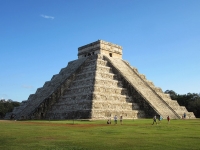
Chichen Itza, with its famous pyramids and temples, is the Yucatan's most visited ancient Mayan site, set in the jungle and said to have been inhabited for more than 2,000 years. The main attraction at Chichen Itza is the Pyramid of Kukulkan (the plumed serpent god), or El Castillo, a grand pyramid topped by a temple that dominates the site and has been declared one of the 7 New Wonders of the World. Inside the pyramid is a smaller pyramid, the inner sanctum, containing one of the greatest finds on the site, the brilliant red jaguar throne with jade spots, inlaid eyes and real jaguar teeth. Another building of interest is El Caracol (The Giant Conch Snail), an observatory with slits in the dome aligned with certain astronomical appearances at specific dates. Visitors should bring drinking water, sunscreen and comfortable walking shoes.
Transport : Bus services from Cancun or Playa del Carmen (2.5hrs by bus)
Opening times : Daily 8am to 4.30pm. Light and sound show begins 7pm (autumn and winter) and 8pm (spring and summer).
Admission : MXN 98, including show. Translation headphones are MXN 25 each.
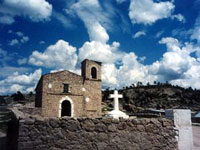
The rustic logging town of Creel is the gateway to the Copper Canyon, popular as a starting point for exploring the canyons and Tarahumara Indian country. The Ferrocarril Chihuahua al Pacifico (ChePe) train runs along the main canyon between Chihuahua and Los Mochis. The trip takes about 15 hours, passing through dramatic scenery and several villages and is a popular way to explore the region. Creel is the largest town in the canyon and offers accommodation, restaurants, Tarahumara craft shops, tours and guides. Situated high in a valley, the cool mountain air at 7,677 feet (2,340m) makes a pleasant escape from the humidity on the coast. Travellers should note, however, that there have been incidents of cartel-related violence in the vicinity of the Copper Canyon, and should take all possible safety precautions.
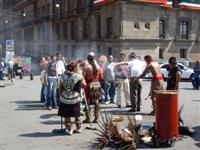
The enormous paved Plaza de la Constitucion, or Zocalo, is the second largest city square in the world. Dominated on one side by the magnificent colonial Presidential Palace, and on the other by the great Metropolitan Cathedral with its ornate interior, the square is Mexico City's centre of government and religion. The square itself is always filled with activity, with vendors and buskers, informal traditional Aztec dance performances, family groups, workers on lunch break and passing tourists. Every evening the presidential guards, in a show of great ceremony, lower the national flag from the central flagpole. The square is constantly encircled by the city's ubiquitous green Volkswagen taxis, and is a good starting point for those wanting to explore the city.
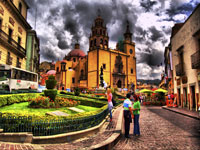
Guanajuato is a colonial gem, founded around the rich silver deposits discovered by the Spanish in 1558. The city has an unusual layout, crammed into a narrow valley, with houses and streets forced into irregular positions due to the naturally hilly topography. Brightly painted houses perch on slopes reached by narrow cobbled alleyways, hidden plazas, steep stairways and underground tunnels. The most narrow, and most visited, alley is the Callejón del Beso (Alley of the Kiss) where the balconies of the leaning houses on either side almost touch each other, a feature in the local romantic legend about furtive lovers exchanging kisses. Every weekend the famous strolling musicians, or callejoneadas, in traditional dress, lead processions through the narrow winding alleyways, strumming, singing and telling stories to the crowds that follow.
Transport : Bus from Mexico City (about four hours).
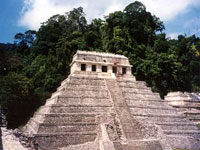
The setting for this spectacular ancient Mayan city is splendid, a hauntingly beautiful site engulfed in the endless tropical jungle that bristles with the shriek of insects. The architecture is fantastic and for many Palenque is the most remarkable of the major Mayan sites. Early morning is the best time to capture the setting at its most photogenic, when swirling vapours encircle the temples and the jungle. The highlight is the tallest and most important of Palenque's buildings, the magnificent Temple of Inscriptions. Constructed on eight levels, the rear interior wall is decorated with panels of Mayan hieroglyphic inscriptions describing the history of Palenque and the temple. There is a museum near the entrance of the site.
Address : Four miles (6.5km) from Palenque town.
Transport : Frequent minibus services from Palenque town.
Opening times : Daily 8am to 4.30pm.
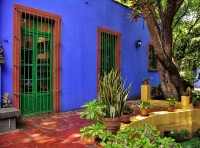
Formerly a separate village, San Angel is one of the more charming of Mexico's suburbs, an exclusive neighbourhood with ancient mansions and colonial houses along cobbled streets. It is famed for its Saturday craft market in the pretty Plaza San Jacinto, which brings colour, crowds and a festive atmosphere to the area, and has excellent art and handicrafts for sale. The suburb is crammed with little restaurants and cafes, several museums exhibiting the works of Frida Kahlo among others, and the lovely El Carmen complex consisting of a triple-domed church, a former monastery, school buildings, and a museum. San Angel is surrounded by a volcanic rock bed called the Pedregal. Parts of this unusual landscape have been declared protected areas where visitors can see the endemic flora and fauna.
Address : Southwest of Mexico City
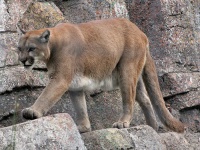
The Sierra de la Laguna Biosphere Reserve, located in the mountains south of La Paz, provides a rugged home for an incredible diversity of animal and plant life. Declared a UNESCO Global Biosphere Reserve in recognition of its distinctive fauna and flora, the reserve is home to mountain lion, coyotes, foxes, kangaroo rats, desert mule deer, gophers and badgers. This ecological treasure house attracts hikers, mountain bikers and naturalists keen to see cacti, palms and pine trees grow side by side and picturesque rock pools form underneath towering granite boulders. The core of the reserve is dominated by scenic oak-pine forests, which although scenic, can make it difficult to spot animals.
Templo Mayor (Great Temple) was the principal temple of the Aztecs, believed to mark the centre of the universe. It was part of the sacred complex of the ancient city of Tenochtitlan, and today it has been excavated to show the multiple layers of construction. The temple was first built in 1375, and enlarged several times, each rebuilding accompanied by a frenzied bloody sacrifice of captured warriors to rededicate the sacred area. Within the site is the excellent Museo del Templo Mayor, displaying artifacts from the original site including a great wheel-like stone carving of the Aztec goddess of the moon, Coyilxauhqui. The entrance fee covers admission to both the museum and the archaeological site.
Address : Seminario 8, Historical District
Website : www.templomayor.inah.gob.mx/english
Telephone : +52 55 4040 5600
Transport : Take metro to Zocalo. Templo Mayor is off Zocalo, to the right of the city cathedral if you face it.
Opening times : Tuesday to Sunday 9am to 5pm.
Admission : MXN 64
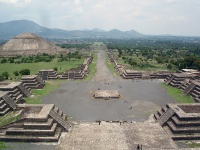
Situated 31 miles (50km) from Mexico City, the UNESCO World Heritage Site of Teotihuacan is Mexico's largest ancient city, dating from around 300-600 BC. Legend has it the Aztecs found the abandoned city and, recognising signs of its previous magnificence, they named it what it is today: Teotihuacan, 'place of the gods'. The central thoroughfare of Teotihuacan is the Avenue of the Dead, a 1.3 mile (2km) stretch connecting the three main attractions. The Pyramid of the Sun is the third largest pyramid in the world, a huge red painted structure over a cave with spectacular views from the top. The smaller, more graceful Pyramid of the Moon contains an alter believed to have been used for religious dancing. The Citadel is a large square complex that was once the residence of the city's ruler. Within the walls is its main feature, the Templo de Quetzalcoatl.
Telephone : +52 59 4956 0276/0052
Transport : Teotihuacan bus departs from Gate 8 of Mexico Citys Terminal del Norte every half hour
Opening times : Tuesday to Sunday 9am-5pm.

Travel Guide powered by Word Travels, copyright © 2023 Globe Media Ltd. By its very nature information in this travel guide is subject to change at short notice and travellers are urged to verify information on which they're relying with the relevant authorities. Neither Globe Media Ltd nor Travel Vogue can accept any responsibility for any loss or inconvenience to any person as a result of information contained above.